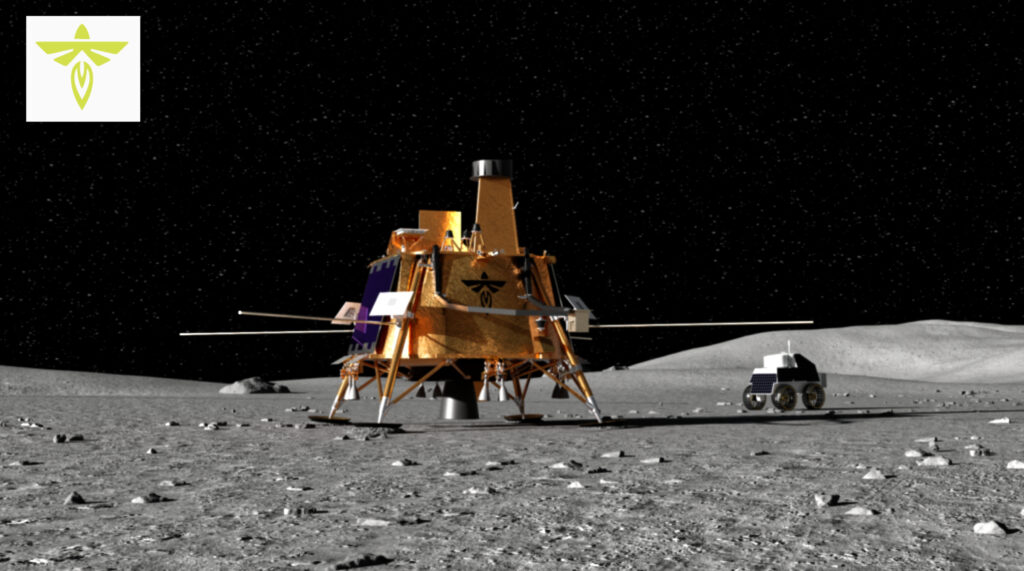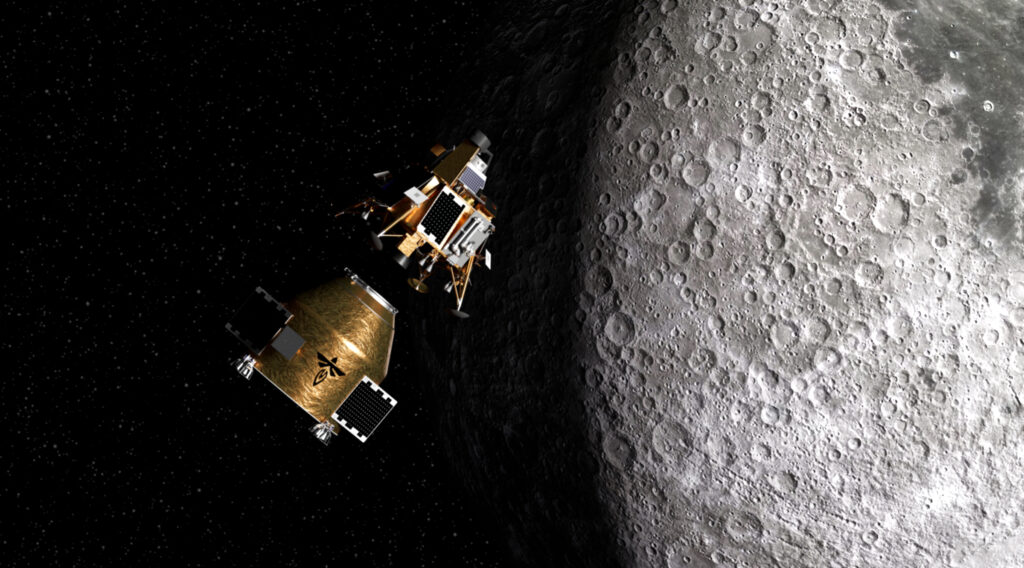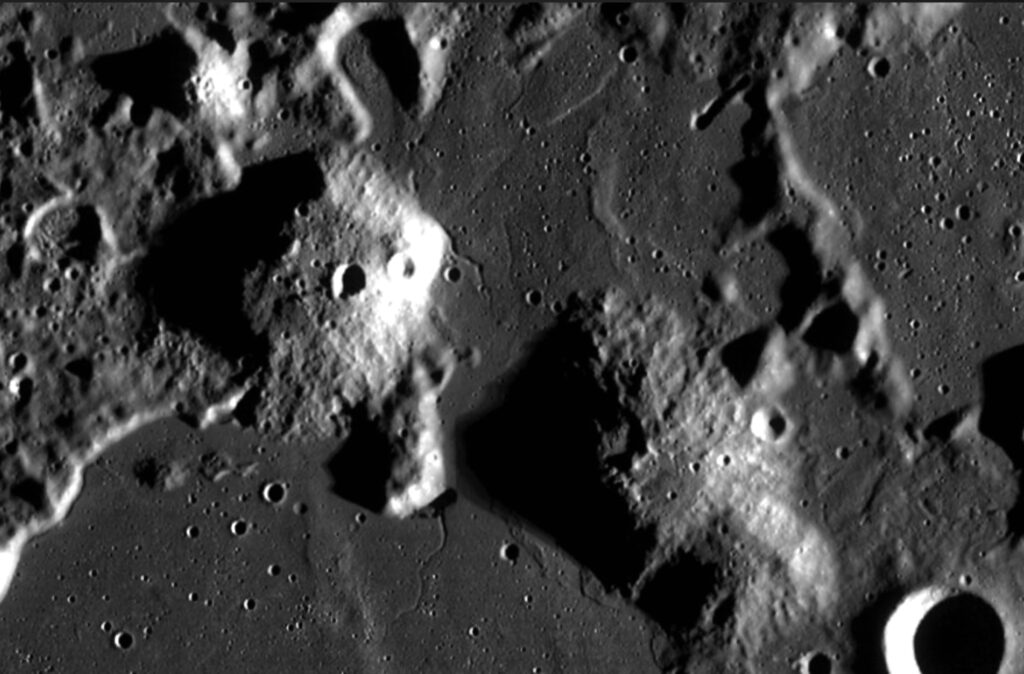
Firefly Aerospace, Inc. has been awarded an approximately $179.6 million NASA contract to deliver and operate six NASA instruments in the Gruithuisen Domes on the Moon’s near side in 2028.

deploying Firefly’s Blue Ghost lander into lunar orbit.
As part of NASA’s Commercial Lunar Payload (CLPS) initiative, the mission will use Firefly’s Blue Ghost lunar lander, Elytra Dark orbital vehicle and a rover from an industry provider to investigate the unique composition of the Gruithuisen Domes – a part of the Moon that has never been explored.

During mission operations, Firefly’s Elytra Dark transfer vehicle will first deploy the Blue Ghost lander into lunar orbit and then remain on-orbit to provide long-haul communications. Blue Ghost will then land in the Gruithuisen Domes, deploy the rover, and support payload operations for more than 14 days on the lunar surface.
The NASA payloads onboard Blue Ghost include the Radio-wave Observations at the Lunar Surface of the photoElectron Sheath (ROLSES) telescope, the Sample Acquisition, Morphology Filtering, and Probing of Lunar Regolith (SAMPLR) robotic arm, the Neutron Measurements at the Lunar Surface (NMLS) instrument, the Photovoltaic Investigation on the Lunar Surface (PILS) instrument, and the Heimdall camera system.
The mission will also carry NASA’s Lunar Vulkan Imaging and Spectroscopy Explorer (Lunar-VISE) payload with multiple instruments attached to both the lander and rover to determine the composition of the Gruithuisen Gamma Dome.
Considered a geologic mystery, the Gruithuisen Domes appear to be composed of silica-rich volcanic minerals that could indicate the presence of lunar water and hydrogen. The NASA payloads onboard Blue Ghost Mission 3 will investigate the formation and physical properties of the domes, including the potential detection of water and hydrogen molecules, in addition to other science investigations.
Along with the NASA payloads, Firefly’s mission has capacity for additional customers, offering orbital transfer and long-haul communications in cislunar space on Elytra as well as lunar surface delivery and operations on Blue Ghost.
Firefly’s first mission to the Moon, Ghost Riders in the Sky, is on track for launch in mid-January 2025 with 10 NASA payloads onboard Blue Ghost. Firefly’s second lunar mission is scheduled to launch in 2026, utilizing a similar two-stage spacecraft configuration as Blue Ghost Mission 3, with the Blue Ghost lander stacked on Elytra Dark to support payload operations on the far side of the Moon and in lunar orbit.
“Firefly is proud to land our fourth NASA CLPS award for another complex mission, which is what our team does best,” said Jason Kim, CEO of Firefly Aerospace. “This incredible team gained a hard-earned reputation for smooth payload integrations, well-rehearsed operations, and robust testing and transparency throughout Blue Ghost Mission 1 preparations. As Firefly works towards becoming the go-to commercial company to provide autonomous systems on the Moon and beyond, our robust line of vehicles stand ready to deliver a historic mission to the Gruithuisen Domes.”
“Firefly is dedicated to flying annual missions to the Moon for both government and commercial customers as we continue to pave the way for a lasting lunar presence,” said Brett Alexander, Chief Revenue Officer at Firefly Aerospace. “We’re seeing growing interest from organizations looking to unlock the Moon’s resources and build a robust lunar ecosystem, and we welcome additional partners to join us.”
The NASA instruments, collectively expected to be about 215 pounds (97 kilograms) in mass, include:
- Lunar Vulkan Imaging and Spectroscopy Explorer, which consists of two stationary and three mobile instruments, will study rocks and regoliths on the summit of one of the domes to determine their origin and better understand geologic processes of early planetary bodies. The principal investigator is Dr. Kerri Donaldson Hanna of the University of Central Florida, Orlando.
- Heimdall is a flexible camera system that will be used to take pictures of the landing site from above the horizon to the ground directly below the lander. The principal investigator is Dr. R. Aileen Yingst of the Planetary Science Institute, Tucson, Arizona.
- Sample Acquisition, Morphology Filtering, and Probing of Lunar Regolith is a robotic arm that will collect samples of lunar regolith and use a robotic scoop to filter and isolate particles of different sizes. The sampling technology will use a flight spare from the Mars Exploration Rover project. The principal investigator is Sean Dougherty of Maxar Technologies, Westminster, Colorado.
- Low-frequency Radio Observations from the Near Side Lunar Surface is designed to observe the Moon’s surface environment in radio frequencies, to determine whether natural and human-generated activity near the surface interferes with science. The project is headed up by Natchimuthuk Gopalswamy of NASA’s Goddard Space Flight Center in Greenbelt, Maryland.
- Photovoltaic Investigation on the Lunar Surface will carry a set of the latest solar cells for a technology demonstration of light-to-electricity power conversion for future missions. The experiment will also collect data on the electrical charging environment of the lunar surface using a small array of solar cells. The principal investigator is Jeremiah McNatt from NASA’s Glenn Research Center in Cleveland.
- Neutron Measurements at the Lunar Surface is a neutron spectrometer that will characterize the surface neutron radiation environment, monitor hydrogen, and provide constraints on elemental composition. The principal investigator is Dr. Heidi Haviland of NASA’s Marshall Spaceflight Center in Huntsville, Alabama.
